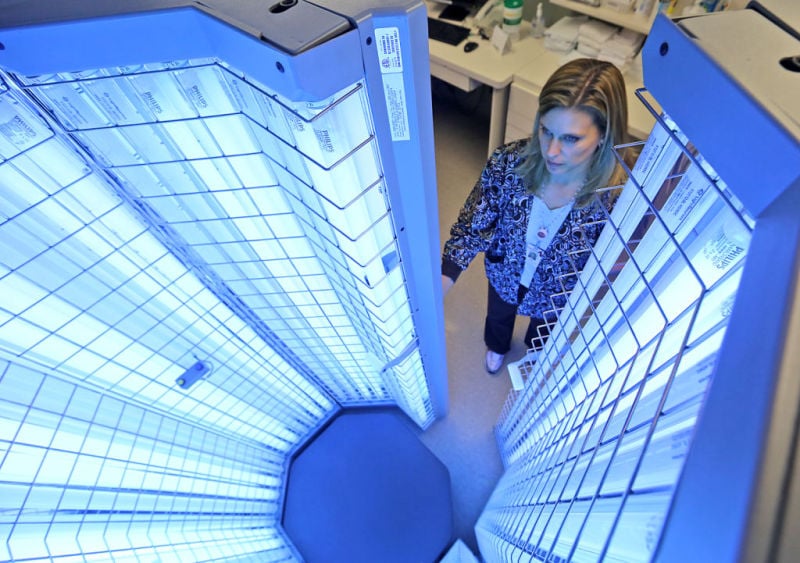Table of Contents
Phototherapy Treatment for Depression, Acne, Psoriasis, Ulcer and Wound
Light therapy, also called phototherapy or heliotherapy, is the fact a patient is exposed to light for a specific amount of time or at a specific time of the day to get healed or relief from a medical condition. Different kinds of lights can be used during the therapy; however, most commonly used include lasers, fluorescent lamps, LEDs and dichroic lamps.
The history behind the therapy started from antiquity. Different ancient cultures practiced various forms of light therapy, mainly: Ancient Greece, Ancient Egypt, and Ancient Rome. Some cultures such as the ancient Indians had a form of treatment combining herbs with natural sunlight to treat non-pigmented skin areas. It is also believed that the Buddhists used the sun light as a therapy about 200 AD and 10th-century.
 However, it took decades before phototherapy became appreciated by medical savants for light therapy to be used as depression treatment. A Faroese-Danish physician and scientist, Niels Ryberg Finsen, is considered to be the father of modern heliotherapy. Mr. Niels Ryberg Finsen developed the first artificial light source to treat lupus vulgaris. He received the Nobel Prize in medicine and Physiology in 1903 for his contribution to the treatment of diseases, especially lupus vulgaris, with concentrated light radiation. Ever since the invention of Finsen, a new avenue for medical science has opened. A variety of treatments have been developed from the use of controlled light.
However, it took decades before phototherapy became appreciated by medical savants for light therapy to be used as depression treatment. A Faroese-Danish physician and scientist, Niels Ryberg Finsen, is considered to be the father of modern heliotherapy. Mr. Niels Ryberg Finsen developed the first artificial light source to treat lupus vulgaris. He received the Nobel Prize in medicine and Physiology in 1903 for his contribution to the treatment of diseases, especially lupus vulgaris, with concentrated light radiation. Ever since the invention of Finsen, a new avenue for medical science has opened. A variety of treatments have been developed from the use of controlled light.
Light Therapy Depression Treatment
You may stumble this term, “light therapy depression treatment”, on Google many times. The reason is because these days, light therapy is used to treat many medical conditions such as seasonal affective disorder (seasonal depression) and skin conditions like psoriasis. As medical science is making progress, other applications are included in the therapy: low level laser, red light, near-infrared and ultraviolet lights for pain management, hair growth, skin treatments, accelerated wound healing.
Techniques of Phototherapy
Different techniques can be used in light therapy. The two most common include Photodynamic therapy and Light boxes.
Photodynamic Therapy (PDT): During this treatment, photosensitive liquid is injected into the body of the patient. Once in the body, the liquid is attached to diseased cells, and becomes solid once exposed from outside to the therapeutic light. Unhealthy cells cannot continue to live, and thus killed. Using blue light with aminolevulinic acid, photodynamic therapy is used to treat actinic keratosis. In addition, PDT is also performed to treat macular degeneration, different types of malignant tumors (cancers), and some other medical conditions.
 Light Boxes: This technique of light therapy consists of using brightness and color temperature of light from a lightbox. During light therapy, it can be used either a lightbox which emits up to 10,000 lux of light, much brighter than a customary incandescent lamp; or a lower intensity of specific wavelengths of light from the blue (470 nm) to the green (525 nm) areas of the visible spectrum. Newer light therapy devices use LED technology, making them much smaller and more convenient for users.
Light Boxes: This technique of light therapy consists of using brightness and color temperature of light from a lightbox. During light therapy, it can be used either a lightbox which emits up to 10,000 lux of light, much brighter than a customary incandescent lamp; or a lower intensity of specific wavelengths of light from the blue (470 nm) to the green (525 nm) areas of the visible spectrum. Newer light therapy devices use LED technology, making them much smaller and more convenient for users.
“Phototherapy Depression Treatment”
Phototherapy has a variety of indications when it comes to depressive disroders.
Seasonal Depression (or Seasonal Affective Disorder): as the name indicates, seasonal depression is a form of depressive disorder in which an individual experiences depression symptoms during the winter months. Seasonal affective disorder (SAD) tends to strike in countries near the North Pole, in seasons where there is reduced amount of daylight. The fact seasonal depression is resulted from low daylight, light boxes are used to replicate sunlight to relieve the symptoms of the disease. To learn more, visit our Seasonal Depression section.
Clinical Depression: This non-seasonal form of depression also responses well to light therapy. In fact, in many patients, the therapy has shown better and faster results compared to the use of antidepressants which most patients do not like to take due to serious side effects. Visit Clinical Depressive Disorder to learn more.
Delayed Sleep Phase Syndrome (DSPS) or Delayed Sleep–Phase Disorder (DSPD): This disorder causes the major sleep episode to delay by 2 or more hours of the desired bedtime, leading to difficulty of awakening at the desired time in the morning. To prevent the disorder, the light is provided as soon as the patient wakes up to cause a dawn simulation.
Phototherapy Treatment for Acne, Psoriasis and Ulcer
In addition to mood and sleep related disorders, the therapy is used to treat a variety of skin diseases such as acne, psoriasis, and wound.

Acne: As we all know, sunlight is enemy of bacteria. Light therapy has been used to treat bacterial acne, a form of acne caused by bacteria which is most prevalent among adolescents. The visible violet light which is present in the sunlight activates a porphyrin that damages and kills the bacteria. Light therapy has been proven to provide better results in treating bacterial acne than Benzoyl Peroxide which is often used to cure acne. However, it can damage the retina if the eyes are not well-protected during the therapy.
Psoriasis: this is an autoimmune disease that causes skin redness, irritation and inflammation. In fact, the inflammation is often the most common problem of people suffering with psoriasis. To relieve the inflamed skin, band ultra violet B rays are given as a light therapy on the surface of the infected skin to help suppress the inflammation.
Wound or Ulcer: Nitric Oxide increases heart rate, thus blood circulation. Session of Infrared Light Therapy directed to the wounded skin releases nitrous oxide in the blood stream which increases the circulation of blood in the wound area, thus increases the healing process. This therapeutic approach is helpful in treating patients suffering with neuropathy (damage to nerves of the peripheral nervous system due to disease or trauma), diabetic wound, and other form of ulcers.
Light Therapy Side Effects and Contraindications
Although phototherapy offers advantages, it can also cause health problems. In addition, there are certain condition in which heliotherapy is not recommended. Too much light during the therapy can cause skin damage as well as destruction or reduction of the amounts of vitamins A and C in the skin, leading to overgrowth of free radicals in the body.
It is also observed that heliotherapy used to treat patients suffering from depression can also cause mania (state of abnormally elevated or irritable mood) due to mood alteration caused by the therapy. This maniac attitude is similar to symptoms people experience when taking mood-altering drugs. It is therefore recommended to undergo phototherapy by and under the surveillance of a qualified medical practitioner.
Phototoxic reactions can occur when there is damaging effects of light-activated compounds on cell membranes. In patients that develop phototoxicity, adverse reaction to ultraviolet light or sunlight, the therapy must be stopped immediately.
Light therapy is not recommended in patients that are taking certain medicines or suffer from a medical condition that can cause photosensitive skin. And finally, patients that have a tendency towards manic behavior, heliotherapy should be forbidden.
External Source: http://www.stanford.edu/~dement/delayed.html



